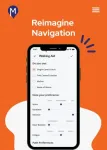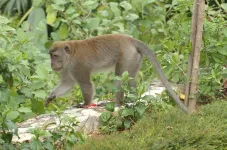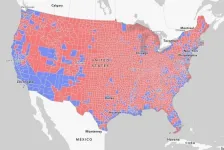(Press-News.org) Vinod Namboodiri, joint faculty member of Lehigh University’s College of Health and P.C. Rossin College of Engineering and Applied Science, has been awarded Phase 2 funding from the National Science Foundation’s (NSF) Convergence Accelerator to further develop a digital app to help persons with disabilities navigate indoor environments successfully.
MABLE: Mapping for Accessibility in BuiLt Environments provides persons with disabilities independence to experience large events, conferences and educational programs. Using crowdsensing, AI and robotics, MABLE empowers individuals with responsive maps and turn-by-turn instructions through a digital app to help them navigate indoor environments successfully.
Key users include those with visual or mobility impairments, such as people with low vision and wheelchair users, as well as other persons with planning and navigation assistance needs.
“The premise of the challenge that I’ve been trying to solve is ‘How do you make it easier for everyone?’” said Namboodiri. “Not necessarily those who know the building well, but anyone in unfamiliar environments. Even those without disabilities often struggle.”
Namboodiri’s team was one of the 16 teams that participated in Phase 1 of the NSF’s Convergence Accelerator, Track H: Enhancing Opportunities for Persons with Disabilities. At the end of Phase 1, the teams participated in a formal pitch and proposal evaluation. In December 2023, the NSF selected MABLE and five other projects to move forward in Phase 2, investing $30 million across all projects with up to $5 million in funding for each project.
In Phase 2, Namboodiri and his team will continue to apply Convergence Accelerator fundamentals to develop solution prototypes and to build a sustainability model to continue impact beyond NSF support. By the end of the 24-month Phase 2 effort, teams are expected to provide high-impact solutions that address societal needs at scale.
Namboodiri’s project and Convergence Accelerator funding connect directly with the College of Health’s core focus on advancing health equity. Specifically, the College of Health recently started a research cluster focused on disability health equity—with Namboodiri at its head— coinciding in focus with the Convergence Accelerator’s Track H.
Additionally, the College of Health takes a comprehensive and multidisciplinary approach to health research, and emphasizes the importance of Community Based Participatory Research (CBPR) and community involvement in the pursuit of health equity. Similarly, Convergence Accelerator research topics begin through gathering input from the community, meet a societal need at scale, and are built upon foundational research and are suitable for a multidisciplinary, convergence research approach.
“A convergence approach between researchers, innovators, and persons with disabilities spanning organizations and communities across multiple sectors is crucial to ensure these NSF-funded solutions address barriers to employment, freedom of movement and quality of life for persons with disabilities,” said Douglas Maughan, head of the NSF Convergence Accelerator program. “The selected Phase 2 teams are fostering strong partnerships to ensure their use-inspired solutions assist a wide range of people.”
The NSF’s Convergence Accelerator transitions basic research and discovery into practice through innovation processes like human-centered design, user discovery and team science, as well as integration of multidisciplinary research and partnerships. By making timely investments, such as Namboodiri’s project, the Convergence Accelerator aims to solve high-risk societal challenges through use-inspired convergence research.
Read the NSF’s press release for more information.
END
NSF-funded project provides digital maps to improve accessibility and navigation for persons with disabilities
Lehigh University researcher awarded grant for MABLE: Mapping for Accessibility in BuiLt Environments, using crowdsensing, AI and robotics to empower individuals with responsive maps and turn-by-turn instructions through a digital app.
2023-12-15
ELSE PRESS RELEASES FROM THIS DATE:
Study identifies Florida’s potential invasive species threats
2023-12-15
In a first-of-its-kind study for North America, scientists accumulated a list of potential invasive species for Florida, and researchers deemed 40 pose the greatest threat.
A team of experts, led by University of Florida scientists, evaluated terrestrial, aquatic and marine species with characteristics that make them particularly adept at invasion. Their list includes 460 vertebrates, invertebrates, algae and plants.
“Invasive species management tends to be reactive, instead of preventative,” said Deah Lieurance, ...
Researchers use environmental justice questions to reveal geographic biases in ChatGPT
2023-12-15
Virginia Tech researchers have discovered limitations in ChatGPT’s capacity to provide location-specific information about environmental justice issues. Their findings, published in the journal Telematics and Informatics, suggest the potential for geographic biases existing in current generative artificial intelligence (AI) models.
ChatGPT is a large-language model developed by OpenAI Inc., an artificial intelligence research organization. ChatGPT is designed to understand questions and generate text responses based on requests from users. The technology has a wide range of applications from content creation and information gathering to data analysis and language translation.
A ...
Using a fiber optic cable to study Arctic seafloor permafrost
2023-12-15
ALBUQUERQUE, N.M. — The Arctic is remote, with often harsh conditions, and its climate is changing rapidly — warming four times faster than the rest of the Earth. This makes studying the Arctic climate both challenging and vital for understanding global climate change.
Scientists at Sandia National Laboratories are using an existing fiber optic cable off Oliktok Point on the North Slope of Alaska to study the conditions of the Arctic seafloor up to 20 miles from shore. Christian Stanciu, project lead, will present their latest findings on Friday, Dec. 15 at AGU’s Fall ...
A unique pathogenic mechanism of SARS-CoV-2 omicron variant: Selective induction of cellular senescence
2023-12-15
“Our findings suggest that the omicron variant, in particular, leads to premature senescence in in vitro, ex vivo, and in lung tissue models.”
BUFFALO, NY- December 15, 2023 – A new research paper was published on the cover of Aging (listed by MEDLINE/PubMed as "Aging (Albany NY)" and "Aging-US" by Web of Science) Volume 15, Issue 23, entitled, “Uncovering a unique pathogenic mechanism of SARS-CoV-2 omicron variant: selective induction of cellular senescence.”
SARS-CoV-2 variants are constantly emerging with a variety of changes in the conformation of the spike ...
UChicago Medicine among the first in the country to offer newly approved sickle cell gene therapies
2023-12-15
The University of Chicago Medicine Comer Children’s Hospital will be among the first in the country to offer gene therapy for sickle cell disease in patients 12 years and older, after federal regulators approved two new treatments on December 8, 2023.
Thousands of patients with sickle cell disease experience vaso-occlusive crises (VOCs), which are often painful and frequently require hospitalization. The two new potentially curative treatments show promise for eliminating VOCs and offer an alternative to bone marrow transplants, which can be arduous and carry risk of rejection even if a matching donor is found.
People ...
Unstable ‘fluttering’ predicts aortic aneurysm
2023-12-15
Northwestern University researchers have developed the first physics-based metric to predict whether or not a person might someday suffer an aortic aneurysm, a deadly condition that often causes no symptoms until it ruptures.
In the new study, the researchers forecasted abnormal aortic growth by measuring subtle “fluttering” in a patient’s blood vessel. As blood flows through the aorta, it can cause the vessel wall to flutter, similar to how a banner ripples in the breeze. While stable flow predicts normal, natural growth, unstable flutter is highly predictive of future abnormal growth and potential rupture, the researchers found.
Called ...
Microbiome insights found in poop help predict infections in liver transplant patients
2023-12-15
In a new study, researchers at the University of Chicago were able to predict postoperative infections in liver transplant patients by analyzing molecules in their poop. Their analysis represents a key leap forward in exploring the connection between the gut microbiome — the bacteria that inhabit the human body — and overall health.
“Antibiotic resistance is growing every year and getting worse. Without antibiotics that work, we can't do things like perform surgeries, protect premature infants or treat cancer,” said Christopher Lehmann, MD, ...
A new tool to better model future wildfire impacts in the United States
2023-12-15
SAN FRANCISCO – Wildfire management systems outfitted with remote sensing technology could improve first responders’ ability to predict and respond to the spread of deadly forest fires.
To do this, researchers at The Ohio State University are testing the use of Synthetic Aperture Radar, or SAR, to help with wildfire detection.
For many ecosystems, fires are vital tools that help to clear away plant waste, provide safer habitats for smaller species and burn off disease. Yet as Earth continues to experience warmer, drier conditions, the likelihood and severity of large, uncontrolled fire incidents that result in widespread ...
Navigating climate challenges: UVA engineers and environmental scientists aid Virginia’s eastern shore
2023-12-15
Because of warming waters and melting glaciers, the sea level at Virginia’s Eastern Shore has risen almost 3 inches since 2016, and the projected trajectory looks ominous. The region, sandwiched between the Chesapeake Bay and the Atlantic Ocean, has one of the highest rates of relative sea-level rise on the Atlantic coast. The Virginia Institute of Marine Science’s Center for Coastal Resource Management projects a relative sea-level rise between 4.5 to 7 feet by 2100, which is three to four times the global average.
Hampton, Virginia — its neighbor across the bay — ranks second only to New Orleans as the largest population center ...
Using AI to pinpoint hidden sources of clean energy underground
2023-12-15
SAN FRANCISCO – As efforts to transition away from fossil fuels strengthen the hunt for new sources of low-carbon energy, scientists have developed a deep learning model to scan the Earth for surface expressions of subsurface reservoirs of naturally occurring free hydrogen.
Researchers used the algorithm to help narrow down the potential whereabouts of ovoids or semicircular depressions (SCDs) in the ground that form near areas associated with natural or “gold hydrogen” deposits. Though these circular ...
LAST 30 PRESS RELEASES:
Numbers in our sights affect how we perceive space
SIMJ announces global collaborative book project in commemoration of its 75th anniversary
Air pollution exposure and birth weight
Obstructive sleep apnea risk and mental health conditions among older adults
How talking slows eye movements behind the wheel
The Ceramic Society of Japan’s Oxoate Ceramics Research Association launches new international book project
Heart-brain connection: international study reveals the role of the vagus nerve in keeping the heart young
Researchers identify Rb1 as a predictive biomarker for a new therapeutic strategy in some breast cancers
Survey reveals ethical gaps slowing AI adoption in pediatric surgery
Stimulant ADHD medications work differently than thought
AI overestimates how smart people are, according to HSE economists
HSE researchers create genome-wide map of quadruplexes
Scientists boost cell "powerhouses" to burn more calories
Automatic label checking: The missing step in making reliable medical AI
Low daily alcohol intake linked to 50% heightened mouth cancer risk in India
American Meteorological Society announces Rick Spinrad as 2026 President-Elect
Biomass-based carbon capture spotlighted in newly released global climate webinar recording
Illuminating invisible nano pollutants: advanced bioimaging tracks the full journey of emerging nanoscale contaminants in living systems
How does age affect recovery from spinal cord injury?
Novel AI tool offers prognosis for patients with head and neck cancer
Fathers’ microplastic exposure tied to their children’s metabolic problems
Research validates laboratory model for studying high-grade serous ovarian cancer
SIR 2026 delivers transformative breakthroughs in minimally invasive medicine to improve patient care
Stem Cell Reports most downloaded papers of 2025 highlight the breadth and impact of stem cell research
Oxford-led study estimates NHS spends around 3% of its primary and secondary care budget on the health impacts of heat and cold in England
A researcher’s long quest leads to a smart composite breakthrough
Urban wild bees act as “microbial sensors” of city health.
New study finds where you live affects recovery after a hip fracture
Forecasting the impact of fully automated vehicle adoption on US road traffic injuries
Alcohol-related hospitalizations from 2016 to 2022
[Press-News.org] NSF-funded project provides digital maps to improve accessibility and navigation for persons with disabilitiesLehigh University researcher awarded grant for MABLE: Mapping for Accessibility in BuiLt Environments, using crowdsensing, AI and robotics to empower individuals with responsive maps and turn-by-turn instructions through a digital app.








